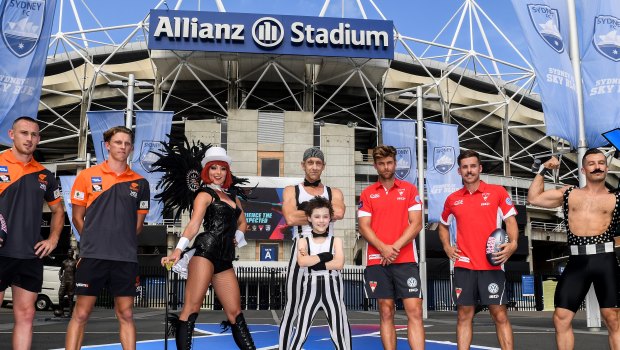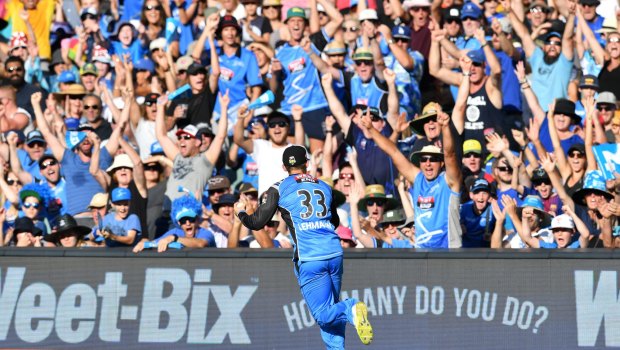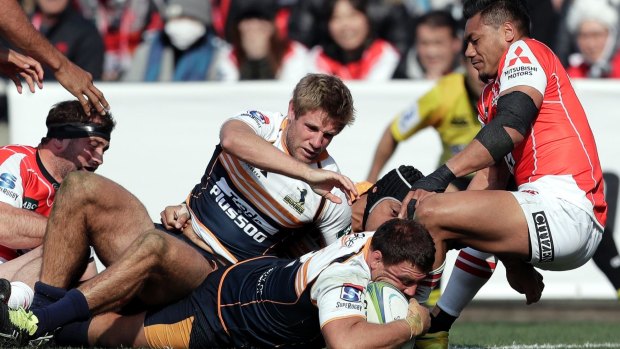- Business
- Small business
- The Venture
This was published 6 years ago
Opinion
Is sport overload killing fan enjoyment?
Tony Featherstone
Finance writerIs there too much professional sport in Australia? As a sports fan, I never thought I’d ask that question. But after a seemingly endless cricket season and an earlier start to AFL through the women’s competition and AFLX experiment, professional sport risks becoming oversupplied and dull.
Every major sport in Australia, it seems, wants to extend its season, add a women’s competition or introduce a shortened version of their game. This new arms race in sport content risks hurting product quality and fan interest.

AFL players Tom Scully and Lachie Whitfield (left), of the Greater Western Sydney Giants, with Dane Rampe and Jake Lloyd (right), from the Sydney Swans, stand with circus performers at the announcement of the 2018 AFLX tournament.
Consider cricket, once an innovation star. It has applied incremental innovation to its core product (Test cricket) through day/night matches, faster over rates and the like. Some, like me, say there has been too much change to the game’s traditions; others say not enough.
Cricket has found new markets for its product: a successful women’s competition, for example. And it has driven radical innovation through the Twenty20 phenomenon, here and overseas. Few for-profit companies have been as adept at juggling different streams of innovation or managing the “creative destruction” process: if Test cricket fades (please, no), cricket will fight another day.
That’s the good news. The bad news is that Cricket Australia is extending its Big Bash League, and the international season in summer seems to morph into almost year-round cricket.
After embracing Big Bash, I lost interest this year. Scheduling conflicts and blurring with international games dampened its appeal. The international T20 matches barely registered with me. An oversupply of televised cricket diluted product quality.

Scheduling conflicts and blurring with international games have dampened the appeal of Big Bash cricket. Credit: AAP
AFL is another example. Its women’s competition, AFLW, has been a magnificent innovation and AFLX, played on rectangular fields, is a worthwhile experiment. But how much AFL can the public consume before interest in the main game is cannibalised?
The NRL season, too, seems to start earlier and finish later each year and it has ramped up an international women’s competition. The proper season has not started yet and we have already been blasted with trial and testimonial matches.
Tennis Australia reportedly wants to extend its summer series of tournaments before the 2020 Australian Open and there is talk of more lead-up fixtures. Netball launched a shortened version of the game through The Fast5 Netball World Series.
Rugby union expanded too quickly through its Super Rugby tournament and had to cut a few teams this season to improve product quality. Rugby shows the danger of sports trying to build new audiences beyond their core too quickly and hurting the product. Other sports will make the same mistake in the next few years.
I understand the need for professional sporting codes to take risks; the demand for extra, unique content from TV networks; and intense competition across the codes. As one sport innovates, others follow.

Super Rugby has had to cut teams after expanding too quickly. Credit: KIYOSHI OTA
Professional, televised sporting competitions for women in AFL and cricket are long overdue and clearly attract new audiences. Shortened versions of major sports also have their place in a time-poor society that favours faster, higher-impact forms of entertainment.
The problem is when most major sporting codes rapidly expand their product at the same time. And when televised sport feels like wallpaper rather than an event. As in any market, too much extra supply and not enough new demand eventually leads to lower prices.
Worse, it leads to declining product quality and customer fatigue. Does Australia have enough elite sports people to supply this extra content consistently? And will the greater demand increase injury risk and player burnout, and encourage industrial action from players for higher pay?
Professional sport, it seems, risks forgetting a few key rules in business. The first is product scarcity: there’s a reason great companies do not flood their market with a new product; they don’t want to cannibalise their core products and risk losing consumer interest.
Second, smart companies know other forms of innovation can create more value than new products. What if our major football codes slightly shortened their seasons rather than extended them, creating higher-quality “events” for consumers and advertisers?
By promoting regular home-and-away games as major events, our codes could spark bidding wars between cities to host games and new revenue models around travel and conferences. Some of this happens now, but a lot more business-model innovation in sport is possible.
What about key sporting codes complementing, rather than trying to kill, each other? For example, rugby league and rugby union working together to leverage intellectual property, such as sport sciences and training facilities. Or even AFL and cricket, which often share ovals, working together to create the most effective scheduling for both. Yes, it will never happen, despite the logic and potential to create a bigger sports-revenue pie through collaboration.
Also, there’s scope for enhanced process innovation within professional sports. Instead of always launching new franchises, why not encourage Australia’s greatest sporting clubs to manage more codes and leverage their intellectual property and fan base. Again, it’s happening (some AFL/NRL clubs involved in netball, for example,) but too slowly.
Sadly, too much recent sports-code innovation revolves around new products or new ways to distribute content, via smartphones and other channels.
New products are far more glamorous than finding ways to cut costs, share resources or develop extra revenue streams. That is, until sporting markets become saturated, new and established products (which pay the bills) suffer.
And we end up like overseas markets that have soulless professional sport every night of the week, designed for sports-betting agencies, and few at the game watching or enjoying it.